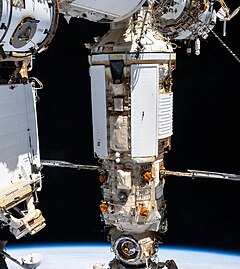
Back Наука (модул) Bulgarian Naüka Catalan Nauka (modul ISS) Czech Nauka German Nauka (módulo ISS) Spanish Nauka (Station spatiale internationale) French נאוקה (מודול) HE Nauka Hungarian Nauka (modul ISS) ID Multipurpose Laboratory Module Italian
 Forward view of Nauka and attached to it from the Cupola, during the Russian VKD-51 spacewalk in January 2022. | |
| Module statistics | |
|---|---|
| COSPAR ID | 2021-066A |
| Part of | International Space Station |
| Launch date | 21 July 2021, 14:58:25 UTC (2 years, 8 months and 28 days ago) |
| Launch vehicle | Proton-M |
| Docked | 29 July 2021, 13:29:01 UTC |
| Mass |
|
| Length | 13.12 m (43.0 ft) |
| Width | ~30 m (98 ft) |
| Diameter | 4.25 m (13.9 ft) |
| Pressurised volume |
|
| Configuration | |
 Diagram of Nauka's forward and aft exterior, with the European Robotic Arm in purple. | |
| External image | |
|---|---|
Nauka (Russian: Наука, IPA: [nɐˈukə], litt. Science), also known as the Multipurpose Laboratory Module-Upgrade (MLM-U; Russian: Многоцелевой лабораторный модуль, усоверше́нствованный, or МЛМ-У) or simply Multipurpose Laboratory Module (MLM), is a module of the International Space Station (ISS). The MLM-U is funded by Roscosmos. In the original ISS plans, Nauka was to use the location of the Docking and Storage Module (DSM). Later, the DSM was replaced by the Rassvet module and Nauka was moved from Zarya's nadir port to Zvezda's nadir port.[1][2][3][4]
The launch of Nauka, initially planned for 2007, was repeatedly delayed. By May 2020, Nauka was reported to be planned for launch in the second quarter of 2021,[5] after which the manufacturer's warranties of some of Nauka's components, such as engines, would have expired.[6] Nauka was finally launched on 21 July 2021, 14:58 UTC, along with the European Robotic Arm, and successfully docked on 29 July 2021, 13:29 UTC, to Zvezda's nadir port, making it the first major expansion of the Russian ISS segment in over 20 years. After Nauka docked, it began firing its engine thrusters in error, causing the entire space station to make one and a half full rotations before the thrusters ran out of fuel, enabling ground controllers to stop the rotation and the crew to get it back to its original position an hour later.[7][8] According to NASA, the ISS crew was never in danger.[9][10][7][11]
- ^ Cite error: The named reference
SFN20200825was invoked but never defined (see the help page). - ^ Morring, Frank (23 May 2012). "Russia Sees Moon Base As Logical Next Step". Aviation Week. Archived from the original on 12 November 2012. Retrieved 29 May 2012.
- ^ "Государственная корпорация по космической деятельности "Роскосмос"". roscosmos.ru. Archived from the original on 21 July 2021. Retrieved 21 July 2021.
- ^ "РКК "Энергия" - Новости - "Наука" на старте". energia.ru. Archived from the original on 21 July 2021. Retrieved 21 July 2021.
- ^ ""Роскосмос" сообщил дату запуска следующего российского модуля на МКС" [Roscosmos announces the launch date of the next Russian module on the ISS] (in Russian). RIA Novosti. 23 May 2020. Archived from the original on 3 June 2020. Retrieved 3 June 2020.
- ^ "Рогозин подтвердил, что на модуль "Наука" поставят баки от разгонного блока "Фрегат"". TASS. 25 March 2019. Retrieved 31 March 2019.
- ^ a b Chang, Kenneth (2 August 2021). "It Was His Day Off. Then the Space Station Went for a Spin". The New York Times. Retrieved 2 August 2021.
In an interview, Mr. Scoville described how the International Space Station spun one-and-a-half revolutions — about 540 degrees — before coming to a stop upside down. The space station then did a 180-degree forward flip to get back to its original orientation. The seven astronauts aboard were never in danger, Mr. Scoville said, and the situation did not spiral out of control. Still, in seven years as a NASA flight director, this was the first time that Mr. Scoville had declared a "spacecraft emergency".
- ^ Smith, Marcia (30 July 2021). "Russia Blames Software Error For Nauka Misfire". Space Policy Online. Retrieved 2 August 2021.
- ^ Morgan McFall-Johnsen, Aylin Woodward (29 July 2021). "Russia's new space-station module fired its engines in error, pushing the entire station into an hour-long spin". Business Insider. Archived from the original on 30 July 2021. Retrieved 29 July 2021.
- ^ Cite error: The named reference
nsf20210729was invoked but never defined (see the help page). - ^ Moran, Norah (29 July 2021). "Space Station Stable After Earlier Unplanned MLM Thruster Firing". blogs.nasa.gov. Archived from the original on 29 July 2021. Retrieved 30 July 2021.
 This article incorporates text from this source, which is in the public domain.
This article incorporates text from this source, which is in the public domain.